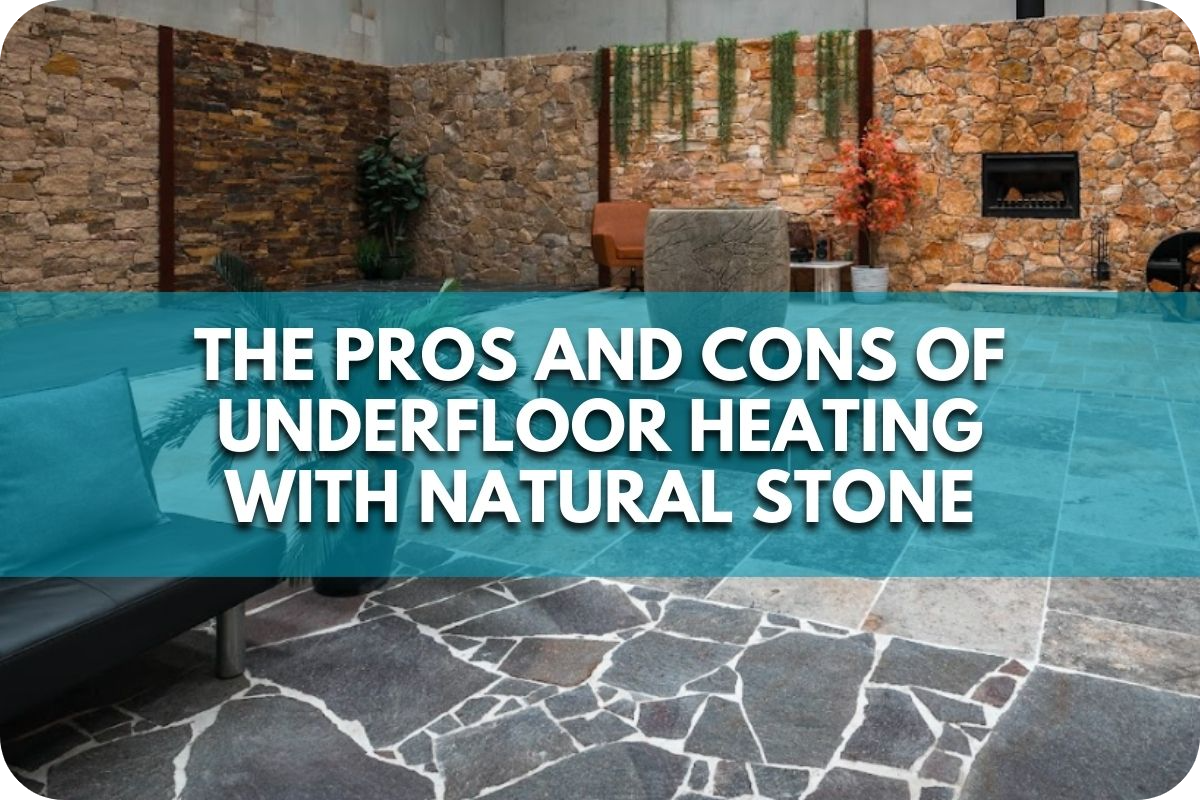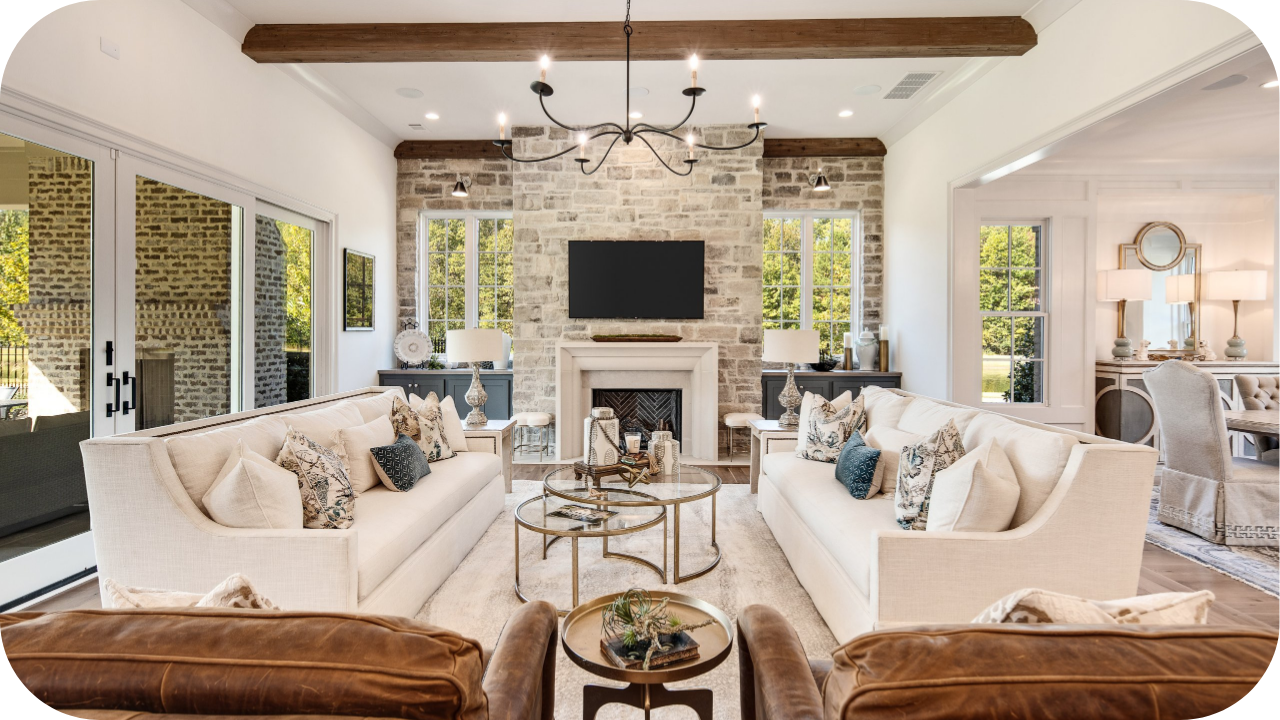
Cold tile floors are a bane during chilly seasons. No one wants to step out of a warm shower onto icy stone.
Underfloor heating is the perfect solution, but it can be costly. On average, underfloor heating installation can range from $5000 to $15000. This raises concerns about whether natural stone is suitable for this type of heating.
Discover the pros and cons of underfloor heating with natural stone to decide if this luxurious upgrade suits your home.
Pros of Underfloor Heating with Natural Stone
Here’s a detailed section on the pros of underfloor heating with natural stone:
- Efficient Heating: Natural stone’s excellent thermal conductivity means it heats quickly and efficiently when paired with underfloor heating. Its heat retention properties keep the floor warm for an extended period, even after the system is turned off. This translates to cosy, consistent warmth throughout your space.
- Luxurious Aesthetic Natural stone offers a timeless elegance that complements any décor style. Popular choices for underfloor heating include marble, limestone, and travertine, all of which provide a beautiful, luxurious element to the room while warmed from underneath. For instance, the natural variations in the colour and pattern of these stones can add depth and visual interest to a space.
- Durability and Longevity: Natural stone is incredibly durable and stands the test of time. When paired with underfloor heating, a well-maintained stone floor will look beautiful for decades, withstanding the heat and pressure without warping or sustaining damage.
- Allergy-Friendly: Underfloor heating eliminates drafts caused by radiators, reducing the circulation of dust, pollen, and other allergens. This, coupled with the easy-to-clean surface of natural stone, contributes to a healthier indoor environment, especially for sensitivities. For instance, the lack of radiators means there are fewer surfaces for the dust to settle on, and even heat distribution can help prevent the growth of mould and mildew.
- Energy Efficiency: Underfloor heating and natural stone can contribute to energy savings. Because the stone distributes the heat evenly and retains it well, the system can operate at lower temperatures than conventional radiators, reducing energy consumption and heating costs.
- Space Saving: Underfloor heating eliminates the need for bulky radiators or heating units, freeing up valuable wall and floor space. This can be particularly beneficial in rooms with limited square footage or areas with a desired minimalist aesthetic.
- Compatibility with Various Flooring Types: While natural stone is a popular choice for underfloor heating due to its thermal properties, the system is compatible with a wide range of flooring materials. Popular choices include marble, limestone, and travertine. This versatility allows homeowners to achieve their desired aesthetic without sacrificing the comfort and efficiency of underfloor heating.
- Enhanced Property Value: Installing underfloor heating with natural stone flooring can increase your property’s value. Potential buyers often perceive this combination as a premium feature, adding to the overall appeal and marketability of the home.
- Low Maintenance: Natural stone flooring is known for its low maintenance requirements, and underfloor heating further simplifies upkeep by eliminating the need for frequent dusting or cleaning around radiators. This makes the combination of underfloor heating and natural stone an attractive option for busy households or individuals seeking a hassle-free flooring solution.
Underfloor heating with natural stone is a versatile solution suitable for various rooms in your home. Whether you’re looking for cosy warmth in your living room or a spa-like ambience in your bathroom, this combination offers comfort and adaptability for any space.
Cons of Underfloor Heating with Natural Stone
Here’s an informative section about the cons of underfloor heating with natural stone:
- Installation Costs: Underfloor heating is inherently more expensive than traditional heating solutions. Combining it with natural stone further increases costs due to material prices and specialized labour requirements. Consider the size of the space and any potential need for modifying existing subfloors. This process typically involves [removing the existing flooring, installing the heating system, and then replacing the flooring with natural stone], which can add to the overall cost and time required for the project.
- Heat Retention: The heat retention properties of natural stone can be a double-edged sword. While excellent for staying warm, your floors will take longer to heat initially and may cool down more slowly when the system is adjusted.
- Compatibility Issues: Only some types of natural stone are ideal for underfloor heating. Some stones may be susceptible to cracking or discolouration due to prolonged exposure to heat. Selecting a suitable stone type and engaging professionals knowledgeable about this combination is crucial.
- Maintenance Requirements: Natural stone requires regular care, especially with underfloor heating. Cleaning and sealing routines have become even more critical in protecting the stone from heat-related stress and potential moisture concerns within the subfloor.
- Potential for Overheating: Underfloor heating, if not adequately controlled, can lead to overly warm floors. This can be uncomfortable and potentially damaging to specific wood furniture placed directly on the heated stone. To prevent this, it’s essential to [install a thermostat with temperature control and limit the maximum temperature to a comfortable level].
- Slow Response Time: Natural stone’s heat retention properties, while advantageous in terms of maintaining warmth, can also result in a slower response time when adjusting the temperature. This means that changes to the thermostat may take longer to feel in the room than with more responsive heating systems.
- Risk of Damage during Installation: Installing underfloor heating with natural stone can pose a risk of damage to the flooring material. Improper handling or accidental impacts during installation can lead to cracks, chips, or other forms of damage, requiring costly repairs or replacements.
- Limited Compatibility with Floor Coverings: While natural stone is compatible with underfloor heating, certain floor coverings, such as thick carpets or rugs, may hinder the heating system’s effectiveness. These materials can act as insulators, preventing heat from adequately transferring to the room above.
- Long-Term Maintenance Challenges: While natural stone is durable, it may require periodic maintenance and repair over time, especially in conjunction with underfloor heating. Issues such as grout deterioration, tile movement, or subfloor moisture problems can arise, necessitating ongoing attention and upkeep to ensure the longevity of the flooring system.
Conclusion
Underfloor heating with natural stone offers luxurious warmth, efficiency, and timeless beauty but comes with costs and considerations.
Weigh your needs, budget, and lifestyle to decide if this upgrade suits you.
For the best selection of natural stone and expert guidance, contact Splendour In Stone Melbourne and elevate your home’s comfort.
More To Explore

Stone Accents: Adding Charm to Modern Interiors with Natural Stone
Modern interiors seek a balance of style, durability, and uniqueness. Natural stone accents are a game-changer, adding timeless elegance and character to any space. As

Natural Stone Features That Will Transform Your Living Room
Natural stone elevates any living room with elegance, texture, and timeless appeal. Its versatility allows it to enhance both modern and traditional spaces. From stone


